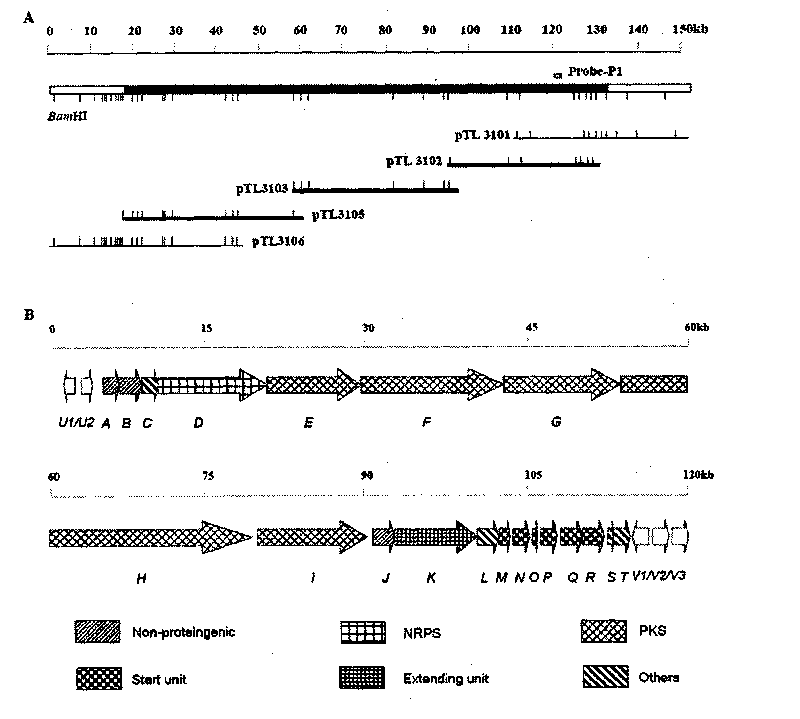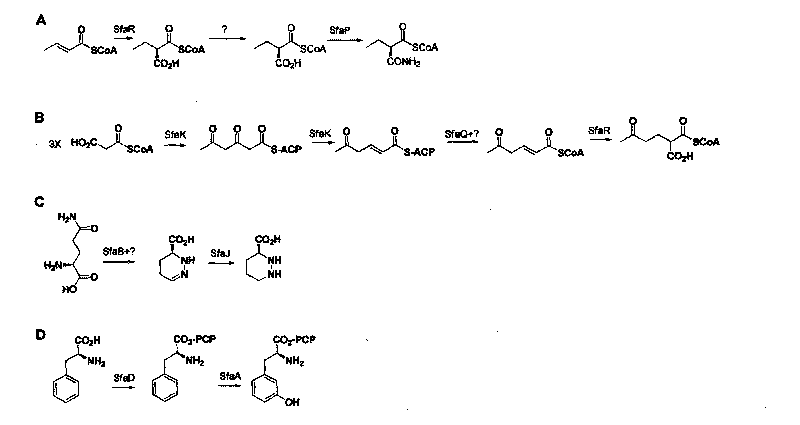Biosynthetic gene cluster of sanglifehrin
A technology of biosynthesis and biosynthesis of sanglifehrin, which is applied in the field of microbial genetic resources and genetic engineering, and can solve problems such as hindering application
- Summary
- Abstract
- Description
- Claims
- Application Information
AI Technical Summary
Problems solved by technology
Method used
Image
Examples
Embodiment 1
[0087] Example 1 Extraction of sangliferin-producing bacteria Streptomyces flaveolus total DNA
[0088]1. Inoculate the spore suspension of S.flaveolus A92-309110 refrigerated at -80°C into 3mL YEME medium, incubate at 30°C for 12h, transfer to 1.5mLEP tubes twice to recover the bacteria by centrifugation, and suspend with 500μL STE solution cells, and added lysozyme to a final concentration of 4mg / mL, and water bathed at 37°C for 30-45min.
[0089] 2. When the cells become transparent gelatinous, add 250 μL 2% SDS, 60 μL 5mol / L KAc, shake and mix evenly, freeze at -20°C for 10 minutes, then centrifuge at 12,000 rpm for 10 minutes, transfer the supernatant to a new In EP tube.
[0090] 3. Add 500 μL equal volume of phenol / chloroform mixture, centrifuge at 10,000 rpm for 3 minutes, repeat several times until no white denatured protein appears at the interface, then extract once with chloroform alone, remove the supernatant and add an equal volume of isoform After mixing the p...
Embodiment 2
[0091] Example 2 Establishment of the Genetic Transfer System of Streptomyces flaveolus, a sangliferin-producing bacterium, Streptomyces flaveolus
[0092] 1. First transform the target plasmid to be transferred into E. coli E. coli S17-1, pick a single clone on the plate and inoculate it into a test tube containing 3 mL of LB medium and corresponding selection pressure and incubate overnight at 37°C. Harvest the bacterial liquid the next day, inoculate 1 mL of the bacterial liquid into a 250 mL Erlenmeyer flask containing 50 mL of LB medium and corresponding selection pressure, and incubate on a shaking table at 37°C until the OD600 value reaches about 0.5. Transfer the bacterial solution to a 50mLEP tube and centrifuge the bacterial solution at 16°C at 3800 rpm for 10min to recover the bacterial cells, then add 20mL LB medium to wash twice and centrifuge again under the same conditions to recover the bacterial cells, resuspend in 1mLLB, and set aside.
[0093] 2. Take a tube...
Embodiment 3
[0096] Example 3 Establishment of the sangliferin-producing bacteria Streptomyces flaveolus gene library Small-scale enzyme digestion experiment
[0097] 1. First determine the amount of Sau3AI by a series of dilution experiments, first prepare a 250 μl reaction system (containing 40 μl of genomic DNA, 2.5 μl of BSA (100×)), and then divide the 250 μl reaction system into 1 × 50 μl and 7 × 25 μl and keep on ice. Then take 2 μl of Sau3AI previously diluted to 0.5u / μl. Add 50 μl of the reaction system in the first tube, mix well and transfer 25 μl to the second tube 25 μl, repeat this transfer step 7 times. All systems were inactivated in a water bath at 37°C for 15 minutes, then inactivated at 70°C for 10 minutes, electrophoresed on a 0.4% agarose gel in a cold room at 4°C, and stained with ethidium bromide to detect the quality of enzyme digestion under ultraviolet light or a gel imager.
[0098] A large number of enzyme digestion experiments
[0099] 2. According to the re...
PUM
 Login to View More
Login to View More Abstract
Description
Claims
Application Information
 Login to View More
Login to View More - Generate Ideas
- Intellectual Property
- Life Sciences
- Materials
- Tech Scout
- Unparalleled Data Quality
- Higher Quality Content
- 60% Fewer Hallucinations
Browse by: Latest US Patents, China's latest patents, Technical Efficacy Thesaurus, Application Domain, Technology Topic, Popular Technical Reports.
© 2025 PatSnap. All rights reserved.Legal|Privacy policy|Modern Slavery Act Transparency Statement|Sitemap|About US| Contact US: help@patsnap.com



